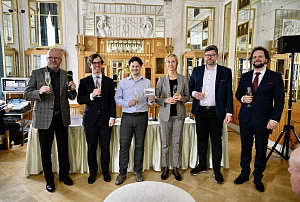
PRAGUE SYMPHONY ORCHESTRA
GENERIC INTERVIEW


On the occasion of the Prague Symphony Orchestra's celebration of their jubilee 90th season, Supraphon released further album dedicated to Prague performed by this top Czech orchestra conducted by their chief coonductor Tomáš Brauner. This time, the musical selections are focused on the end of the 19th century. The Prague Symphony Orchestra is reaffirming that the Czech late-romantic repertoire is the native language most natural to them. Just before the release of the album Smetana, Dvořák, Suk, Ostrčil: Music for Prague, we spoke with the Prague Symphony Orchestra programming director Martin Rudovský.
Can you tell us how the musical selections were chosen for Music for Prague?
Having made a recording devoted to Karel Husa and his evocative composition Music for Prague 1968, we turned our attention to a different portrait of Prague. It is no a less dramatic, but one might say more traditional picture of Prague, that can still be recognised from the city’s present appearance. That is why we chose Dvořák, Smetana, and Suk and their compositions connected with Prague. Some connections with Prague are obvious at first glance, like Smetana’s Vyšehrad and Prague Carnival or Suk’s Praga, but other connections are more below the surface, like the overture Můj domov (My Home), which is part of music that Dvořák wrote at the request of the Provisional Theatre’s management for the play Josef Kajetán Tyl by František Ferdinand Šamberk.
The Tale of Šemík is a virtually unknown symphonic poem written by Otakar Ostrčil at just 19 years of age. How difficult was it to prepare this work?
Of course, it is more difficult to do a work that has been forgotten and is not performed, but then again it is all the more interesting and adventurous to help bring something like that into the world. A challenge, one might say! By the way, there is only one previous recording; it was made, as chance would have it, by our orchestra in 1970. But the symphonic poem is not in its complete form, and the technical quality of the recording is imperfect. So now we have the first complete studio recording.
Dvořák’s Fanfare for the Opening of the National Jubilee Exhibition in Prague is another unique item in this album. What attracted you to it?
It simply fit in terms of its topic, style, and duration. And a fanfare is always appropriate for opening a programme! We’re quite pleased about it because it is otherwise difficult to fit the piece in somewhere, partly because it is written for four trumpets and timpani. We even have a period report: “The maestro Dr. Antonín Dvořák composed the fanfares especially for the occasion, and they were also performed only at exhibition ceremonies by sixteen trumpet players and one timpanist. The sounds of the fanfares made the impression on the public of an indescribable kind of satisfaction and exaltation, and they heightened the people’s enthusiasm to the point of rapturous excitement.” That must have been quite a sound!
What important things await the Prague Symphony Orchestra in the Year of Czech Music?
Lots and lots of Czech music, of course, but also our 90th birthday; the orchestra was established in the autumn of 1934, which was also a Year of Czech Music. For this reason, special concerts have been planned in June at Vyšehrad and in October at the Radio Palace.